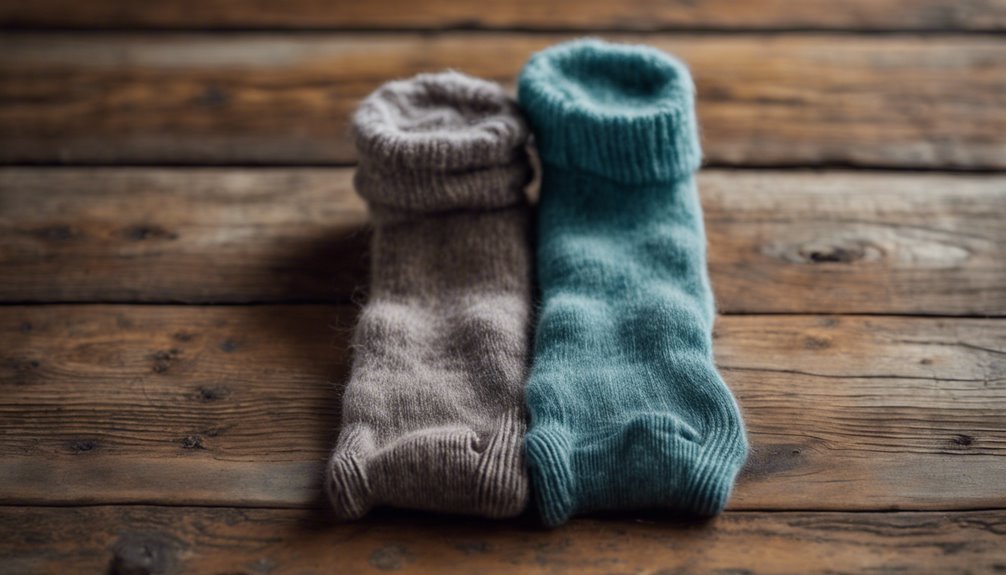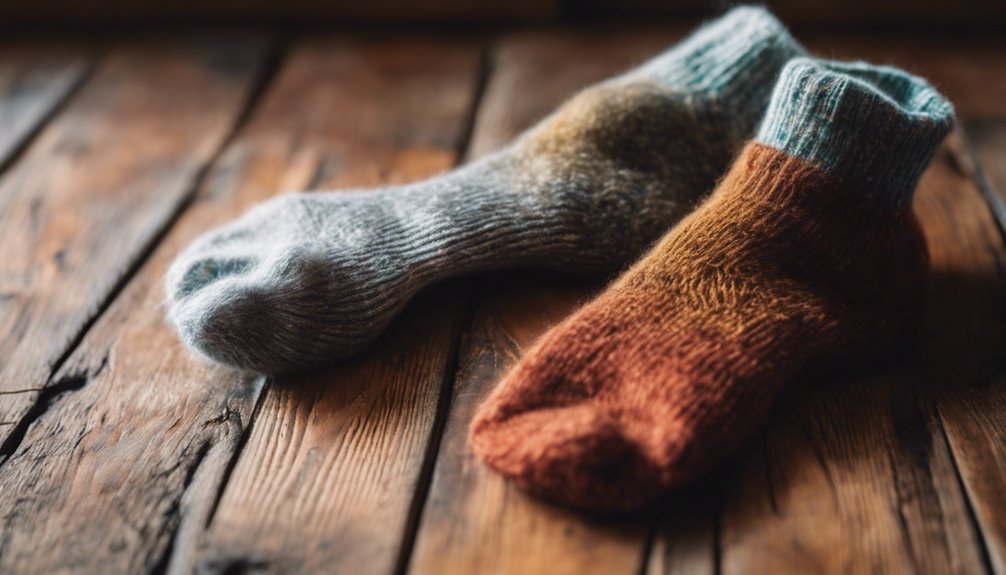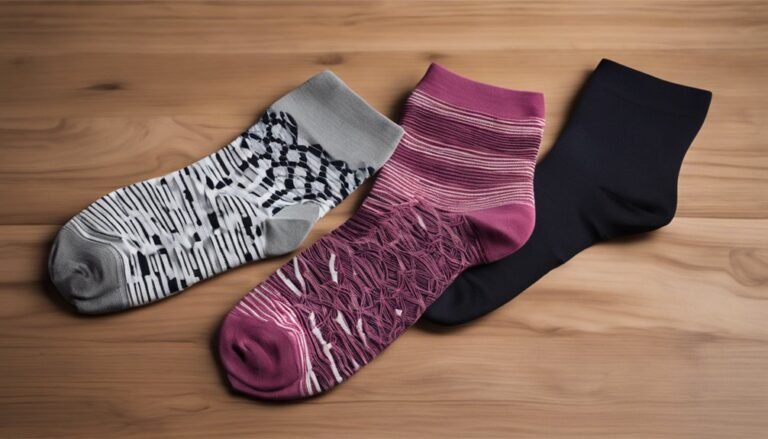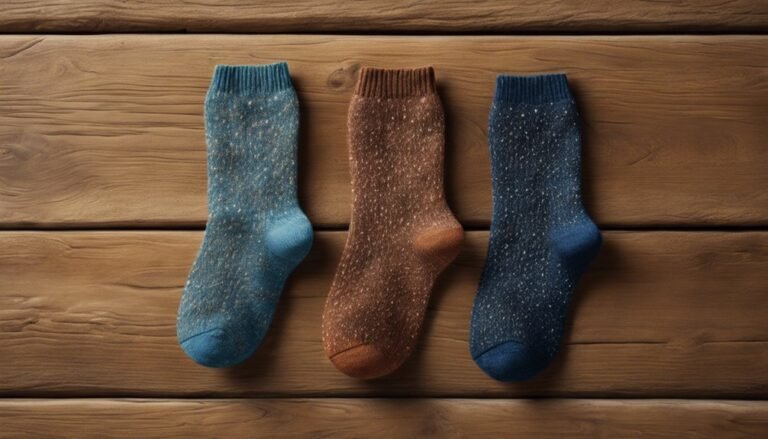Cotton vs. Wool Socks: Which Is Better for Daily Use?
When choosing between cotton and wool socks for daily use, consider your needs. Cotton socks are soft and breathable, making them great for casual wear and warm weather. However, wool socks excel in moisture management, keeping your feet dry and warm during cooler conditions. Wool offers better durability and odor resistance too. Ultimately, your choice should depend on your activities and climate preferences. Discover more insights to help decide what's best for you.
Overview of Cotton Socks

Cotton socks are a popular choice for everyday wear due to their softness and breathability. You'll find a wide range of cotton sock varieties available, catering to different needs and preferences, from athletic to casual styles. They're made with varying blends, often incorporating spandex for better fit and durability. When it comes to cotton sock care, regular washing in cold water is advisable to maintain their shape and softness. Avoiding fabric softeners can prevent reduced absorbency, ensuring your socks remain functional. Additionally, air drying is recommended to extend their lifespan. By understanding the nuances of cotton socks, you empower yourself to choose the right pair that complements your lifestyle while enjoying the freedom of comfort they provide.
Overview of Wool Socks
Wool socks are renowned for their superior insulating properties, making them an excellent choice for cold weather. They also excel in moisture-wicking, helping to keep your feet dry and comfortable during various activities. Understanding these benefits can help you decide if wool is the right material for your sock collection.
Insulating Properties of Wool
While many materials are used for socks, the insulating properties of wool set it apart as an excellent choice for maintaining warmth in cold conditions. Wool's insulating efficiency stems from its unique fiber structure, allowing it to trap air and create a buffer against the cold. This natural material excels at thermal regulation, keeping your feet warm without overheating.
| Property | Wool | Cotton |
|---|---|---|
| Insulating Efficiency | High | Low |
| Thermal Regulation | Excellent | Poor |
| Moisture Retention | Moderate | High |
| Durability | Strong | Moderate |
Choosing wool socks means opting for a reliable solution that combines comfort and warmth, perfect for daily wear in cooler environments.
Moisture-Wicking Benefits
When it comes to moisture management, wool socks offer significant advantages that enhance comfort during wear. Unlike cotton, which tends to retain moisture, wool effectively wicks away sweat, keeping your feet dry and comfortable throughout the day. This moisture-wicking property is essential, especially during physical activities, as it helps regulate temperature and prevents blisters. In a performance comparison, wool socks outperform cotton by maintaining ideal moisture levels, ensuring your feet stay fresh and odor-free. Additionally, wool's natural breathability allows for better airflow, further promoting comfort. For those seeking freedom in their daily activities, choosing wool socks means investing in a product designed to enhance foot health and overall performance.
Breathability and Moisture Management
When choosing between cotton and wool socks, understanding their breathability and moisture management is essential. Wool naturally excels in moisture absorption, allowing your feet to stay dry while regulating temperature effectively. In contrast, cotton tends to retain moisture, which can lead to discomfort and a cooler feel in colder conditions.
Moisture Absorption Capacities
Although both cotton and wool socks offer unique advantages, their moisture absorption capacities greatly impact comfort and performance. Cotton tends to have higher moisture retention but lacks effective drying speed, which can leave your feet feeling damp. In contrast, wool can absorb moisture while still feeling dry, thanks to its natural wicking properties. This means you can enjoy longer wear without discomfort.
| Material | Moisture Retention | Drying Speed |
|---|---|---|
| Cotton | High | Slow |
| Wool | Moderate | Fast |
Choosing the right sock depends on your daily activities. If you're active, wool's quick-drying nature might be preferable, while cotton could suit leisurely days. Consider your needs for ideal foot comfort.
Temperature Regulation Properties
The ability of socks to regulate temperature plays a significant role in overall comfort, influencing your choice between cotton and wool. Both materials offer distinct temperature control techniques that cater to different needs and preferences.
- Cotton is breathable, keeping your feet cooler in warm weather.
- Wool provides excellent insulation, making it ideal for colder conditions.
- Choosing the right material can enhance your seasonal sock choices and overall foot health.
When considering breathability and moisture management, cotton allows sweat to evaporate, while wool wicks moisture away and keeps feet dry. This moisture control is essential for maintaining comfort throughout the day. Ultimately, it's about selecting the sock that best aligns with your climate and activity level, ensuring you stay comfortable and free.
Comfort and Softness
Choosing between cotton and wool socks often comes down to comfort and softness, two essential factors for daily wear. When you consider the softness comparison, cotton typically feels smooth against your skin, providing immediate comfort. Its breathability enhances these comfort levels, making it ideal for warmer days. On the other hand, wool offers a unique softness that can feel plush and cozy, particularly in colder conditions. While some may find wool scratchy initially, many appreciate its natural cushioning and moisture-wicking properties, which can enhance overall comfort. Ultimately, your choice depends on your personal preferences and the conditions you'll face. If you value immediate softness, cotton might be your go-to, but if you want a blend of warmth and softness, wool could win you over.
Durability and Longevity
While comfort and softness play significant roles in sock selection, durability and longevity are equally important factors to evaluate, especially for active lifestyles. When you consider wear and tear, it's essential to assess how long your socks will last under daily conditions.
- Cotton socks generally have a shorter lifespan due to their tendency to wear out faster.
- Wool socks, on the other hand, often resist abrasion and maintain integrity longer.
- Understanding the lifespan comparison can help you make a more informed choice.
Choosing between cotton and wool ultimately depends on your activity level and how often you're willing to replace your socks. Selecting durable materials can guarantee that your investment pays off in the long run.
Temperature Regulation

When it comes to temperature regulation, the breathability of materials plays a vital role in your comfort. Cotton socks often trap heat, leading to discomfort, while wool's moisture management properties help regulate temperature by wicking away sweat. Understanding these differences is key to choosing the right sock for varying conditions.
Breathability of Materials
Breathability in sock materials plays an essential role in temperature regulation, impacting comfort during varying physical activities. When considering cotton and wool, their breathability comparison reveals significant differences rooted in their unique fabric structures.
- Cotton's natural fibers allow for good airflow, keeping your feet cool.
- Wool's insulating properties help regulate temperature, retaining warmth without overheating.
- Both materials can adapt to different conditions, but their effectiveness varies.
Cotton tends to excel in warmer climates, while wool shines in cooler environments, making your choice dependent on your daily activities and climate. Understanding these factors guarantees you select the best sock for your needs, enhancing your comfort and freedom throughout the day.
Moisture Management Properties
Moisture management is essential for maintaining comfort during physical activities, as it directly influences temperature regulation. When you choose socks, consider how well they handle moisture retention and sweat evaporation. Cotton socks tend to absorb moisture but can hold it against your skin, making your feet feel damp and uncomfortable. In contrast, wool socks excel at wicking moisture away, allowing sweat to evaporate quickly. This keeps your feet dry and helps regulate temperature, preventing overheating or chilling. If you prioritize freedom in movement and comfort, wool's superior moisture management properties can make a significant difference. Ultimately, selecting the right sock material can enhance your daily activities by providing ideal temperature control and comfort.
Odor Resistance

Odor resistance plays an essential role in the choice between cotton and wool socks. When you're considering daily wear, you'll want to understand how each material handles odor control and smell retention. Here's how they stack up:
- Wool's Natural Properties: Wool fibers possess lanolin, which helps prevent bacterial growth.
- Cotton's Limitations: While breathable, cotton tends to absorb moisture, creating an environment for odors to develop.
- Performance Under Pressure: Wool excels in longer wear, managing odors better even after prolonged activity.
Care and Maintenance
When it comes to caring for your socks, understanding the differences in maintenance between cotton and wool can greatly impact their longevity and performance. Cotton socks are generally easier to care for; you can toss them in the washing machine without much concern. Just remember to use a gentle cycle and avoid high heat when drying. On the other hand, wool requires more attention. Hand washing or using a delicate cycle is best for wool socks, along with cold water to preserve the fibers. For both types, air drying is ideal to maintain shape and elasticity. By following these fabric care guidelines, you'll guarantee your socks remain comfortable and functional, giving you the freedom to enjoy them longer.
Cost Comparison
After establishing proper care practices, it's important to contemplate the financial aspect of choosing between cotton and wool socks. A price comparison reveals that cotton socks are generally cheaper upfront, but wool socks may offer long-term savings due to their durability and insulation properties.
- Cotton socks usually wear out faster, leading to more frequent purchases.
- Wool's natural moisture-wicking and temperature-regulating features can reduce the need for multiple pairs.
- Investing in quality wool socks may save you money over time, as they can last several seasons.
Ultimately, the choice between cotton and wool comes down to what you value more: initial cost or long-term benefits. Evaluating your lifestyle and needs will guide you to the right decision.
Best Use Cases for Each Material
Choosing the right socks for specific activities can greatly enhance comfort and performance. If you're looking for the best occasions to wear cotton socks, think casual days, light workouts, or warm weather outings. Cotton's breathability and softness make it a go-to for everyday wear. On the other hand, wool socks shine in cooler climates and during outdoor adventures. Their moisture-wicking and insulating properties are perfect for hiking or skiing, where you need both warmth and dryness. Understanding your material preferences is essential. If you prioritize comfort and breathability, cotton is ideal. However, for durability and temperature regulation, wool is unmatched. Tailoring your sock choice to your activities can elevate your overall experience.
Frequently Asked Questions
Can I Wear Cotton Socks in Winter?
You can wear cotton socks in winter, but they may not provide ideal warmth or moisture management. Consider their tendency to retain moisture, which can lead to cold feet in chilly conditions.
Do Wool Socks Cause Itching?
Wool socks can cause itching for some due to wool sensitivity. If you're prone to irritation, consider remedies like wearing a moisture-wicking layer underneath or opting for softer wool blends to enhance comfort and freedom.
Are Cotton Socks Good for Athletic Activities?
Did you know that about 70% of athletes prefer breathable fabrics? Cotton socks excel in breathability factors and moisture management, making them suitable for athletic activities, provided you choose high-quality options that wick sweat effectively.
How Do I Choose the Right Sock Size?
To choose the right sock size, start by measuring your foot. Sock sizing varies by brand, so refer to their specific size charts. Accurate foot measurements guarantee comfort and prevent issues during daily wear.
Can I Machine Wash Wool Socks?
Yes, you can machine wash wool socks, but be cautious. Use a gentle cycle with cold water and a wool-safe detergent. Following these washing tips guarantees your wool care routine keeps them looking great longer.







